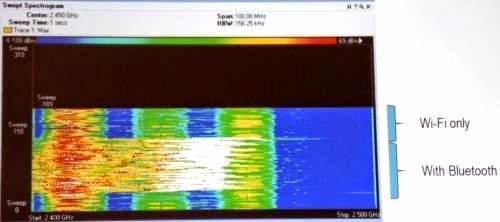The Wireless Challenge - Managing_Your_Wireless_Spectrum_mj2013.pdf
Making Wireless Technology Work in Your Hospital - 2006.wirelesswork.pdf
Books on Healthcare WiFi IT
xxxxx
WiFi Is King at Kaiser | EE Times
WiFi is king at Kaiser, a healthcare provider with $50 billion in annual revenues that manages 28,000 access points and 1.1 million Ethernet ports, said Shawn M. Jackman. Kaiser is testing a cellular network using small cells, but is trying to keep Bluetooth devices off its widely deployed, and crowded 2.4 GHz network.Can Bluetooth and 802.11b/g/n Wi-Fi Devices Coexist? |
Jackman told device makers here to leverage WiFi, especially the 5GHz version. Like many hospitals, Kaiser finds it pervasive, cheap, yet relatively reliable and secure. Devices should be tested rigorously for environments with many access points, security models, and consumer and clinical applications, he said.
Jackman was bearish on bonding schemes for creating broadband 160 MHz channels in 802.11ac. He noted he has not even tapped into the 20 MHz channels needed available under .11n yet. And the 60 GHz .11ad standard is so far a non-starter given its limited range and penetration.
In the 2.4 GHz band, Kaiser maintains a guest network and several other services, leading to an overcrowded spectrum with Bluetooth currently losing the battle for air space. On the horizon, he sees a collision of 2.4 GHz accessories.
“I’m watching this wearables thing and its coming at me like a freight train,” he said.
Jackman said he is thumbs down on patient systems using Bluetooth, at least for data transfers.
It is impractical to keep the Bluetooth and 802.11b/g/n Wi-Fi devices from hearing each other. But by using Time Division Multiplexing (TDM) both the Bluetooth and 802.11b/g/n Wi-Fi devices can coexist by taking turns transmitting over time.In order to minimize the interference, the Bluetooth SIG implemented a signaling mechanism called Frequency Hopping Spread Spectrum (FHSS). The FHSS signaling methodology causes the Bluetooth device to switch the 1 megahertz (MHz) wide channel 1600 times per second across all 79 channels available to Bluetooth.
Wireless Medical Device Coexistence | Medical Electronics Design
At any given time, a typical home or hospital uses a number of wireless systems (e.g., IEEE 802.11a/b/g/n, or WiFi; Bluetooth; ZigBee; cordless phones) operating on the same industrial, scientific, and medical (ISM) band.1,2 Given the increasing use of wireless, RF wireless medical devices and other wireless systems operating nearby can interfere with each other. If a collision between their respective transmissions occurs, data packets transmitted by medical devices could be delayed or blocked, potentially interfering with timely transmissions of critical data. Techniques such as retransmission and forward error correction might no longer be sufficient to overcome interference and spectrum congestion. Hence, methods to design and test wirelessly enabled medical devices for risks associated with coexistence of wireless technologies are essential for innovative, safe, and effective RF wireless medical devices.
Although there is some overlap between electromagnetic compatibility (EMC) and wireless coexistence, differences exist. Wireless coexistence is the ability of one wireless system to perform a task in an environment where other systems that may or may not be using the same set of rules can also perform their tasks.3 EMC is the ability of a device to function properly in its intended electromagnetic environment without introducing excessive electromagnetic energy that could interfere with other devices. Manufacturers of electrically powered medical devices routinely test their equipment to applicable national and international consensus safety standards. EMC test results are often used to support safety claims to regulatory agencies such as FDA. Less well-known are the issues and concerns associated with wirelessly enabled medical devices, although this is changing thanks to FDA’s guidance document on wireless medical devices.4
To date, no consensus standards adequately address the risks associated with wireless coexistence for medical devices and systems. Current methods of evaluating wireless coexistence use ad hoc test methods that vary widely among device manufacturers and test facilities. Moreover, current medical device EMC standards have no requirements or test procedures to assess the performance of systems containing RF receivers in the presence of in-band transmitters. This article examines the limitations of present medical device EMC standards for coexistence evaluation, identifies factors to be examined when testing for coexistence, and discusses the status of plans to develop a wireless coexistence test method.
Gigabit Wi-Fi: 802.11ac is here: Five things you need to know | ZDNet
Some Other References
Four ways to get the most from your 802.11n Wi-Fi | ZDNetUnderstanding where 802.11ad WiGig fits into the gigabit Wi-Fi picture | Network World
IEEE 802.11ad | Microwave Wi-Fi, WiGig | Tutorial
20 Myths of Wi-Fi Interference - Cisco



No comments:
Post a Comment